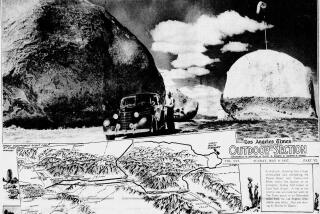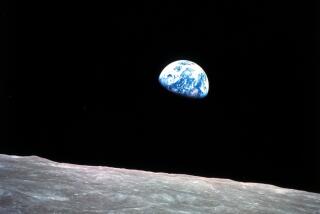Near the Roar of Jet Engines, a Shrine to Early Aviators
- Share via
Once, they soared above the clouds to make history. Now, barnstormers, daredevils and sundry architects of aviation rest beneath the Portal of the Folded Wings, a seven-story shrine under the flight path of Bob Hope Airport in Burbank.
The shrine, with a colorful tile dome and female figures stretching their arms to the heavens, originally was built as an impressive entrance to Valhalla Memorial Park cemetery.
Named for the palace of Odin, the Norse god of slain heroes, Valhalla was founded in 1923 by two Los Angeles financiers, John R. Osborne and C.C. Fitzpatrick. The Spanish Mission Revival entrance structure was designed by architect Kenneth MacDonald Jr.
For the decorative stone castings, MacDonald hired Italian-born sculptor Federico A. Giorgi, who had created 30-foot-tall statues of elephants and lions for the 1917 epic film “Intolerance” and crafted the exterior of downtown’s Million Dollar Theater.
The gateway to the new cemetery cost $140,000 -- $1.5 million in today’s dollars.
Its rotunda was dedicated March 1, 1925, with a concert by English contralto Maude Elliott. Picnickers spread blankets on the surrounding grassy expanse between three reflecting pools and flat cemetery markers, which were a new concept at the time.
“It became a tourist attraction and was used for concerts that were broadcast over radio station KELW by station owner Earl L. White,” said Ron Dickson, docent of the Burbank Aviation Museum.
But just five months after the dedication, Osborne and Fitzpatrick were convicted of fraud. They had sold the same burial plots repeatedly -- as many as 16 times -- and netted a profit of $3 million to $4 million, according to Times stories of the era. They were fined $12,000 each and sentenced to 10 years in prison but served less than half the sentence.
The cemetery was taken over by the state.
It’s unclear how long the state owned the 63-acre cemetery, but Pierce Brothers bought it in 1950 and, within two years, closed the rotunda to vehicle traffic and moved the entry to the cemetery from Valhalla Drive in Burbank to Victory and Cahuenga boulevards in North Hollywood. There, they opened a two-story office and mortuary.
Pasadena aviation historian and enthusiast James Gillette, long impressed with the rotunda’s proximity to the airport and to Lockheed Aircraft, conceived a plan to use the structure as a shrine to aviation. With the support of other aviation pioneers, including World War II hero Gen. Ira Clarence Eaker and the Rev. John F.B. Carruthers, a Navy chaplain and research director of aeronautical history at the Claremont Colleges, Gillette’s plan took wing.
On Dec. 17, 1953 -- the 50th anniversary of Orville and Wilbur Wrights’ 12-second powered hop at Kitty Hawk -- the rotunda was rededicated as the Portal of the Folded Wings. During the ceremony, the cremated remains of Walter R. Brookins were interred there. Brookins, the first aviator to take a plane to an altitude of a mile, had been the Wrights’ first civilian student.
Today, more than 30 bronze plaques adorn the rotunda floor. The honorees include Charlie Taylor, the Wrights’ mechanic, who built the engine that powered the first flight.
When sculptor Giorgi died in 1963, he was buried outside the structure, near his masterpiece. Gillette was also buried outside, near the shrine he helped found.
“It’s possible [Gillette] didn’t deem himself worthy enough to be buried among such famed pilots,” said Iris Critchell, 85, a veteran pilot and former director of the Bates Foundation for Aeronautical Education at Harvey Mudd College in Claremont. “He was a pioneer to us, but to himself, at the time, the people who were buried there were the history.”
The shrine’s most colorful resident is no longer there: daredevil pilot Jimmie Angel, who found the world’s highest waterfall, 3,200-foot Angel Falls, in Venezuela. His ashes were disinterred in 1960, three years after his death, and scattered over the falls, The Times reported.
But his plaque remained at the shrine for years -- at least as late as 1969, when it appeared in a Times news photograph. On July 18, 1969, a small twin-engine Piper Navajo plunged into the dome. The pilot and a passenger were killed; one passenger survived.
The National Transportation Safety Board blamed the crash on pilot error. Investigators found faulty spark plugs, carbon deposits in engine cylinder heads and improperly secured cargo.
The crash was immortalized in Ripley’s Believe It or Not.
Repairs to the building cost $70,000.
No one is sure when Angel’s plaque disappeared. “When I got here more than 10 years ago, there was a space filled in with concrete and no Jimmie,” said Dickson, the docent, who also works as an industrial designer.
That spot now belongs to air and space research engineer Richard Peter Della-Vedowa, who died in 1994.
In 1958, Pierce Brothers sold its family-owned chain of Southern California mortuaries and cemeteries to Texas financier Joseph L. Allbritton, who sold off 20 acres of Valhalla for development. In 1991, the cemeteries and mortuaries were acquired by Service Corp. International in Houston, but the Pierce Brothers sign remains at Valhalla.
The cube-like shrine building was damaged in the 1994 Northridge earthquake but restored and rededicated in 1996. Two years later, it was placed on the National Register of Historic Places.
The building also houses the Burbank Aviation Museum.
Beneath the memorial tablets rest the remains of other aviation pioneers, including:
* Augustus Roy Knabenshue (1876-1960), who in 1904 became America’s first dirigible pilot. He also founded a dirigible passenger service, from Pasadena to Los Angeles, in 1912.
* Evelyn “Bobbi” Trout (1906-2003), who held numerous records for endurance, mileage and altitude.
* James Floyd Smith (1884-1956), who built and flew his own plane in 1912 and invented the free-type manually operated parachute for the Army in 1918.
* Hilder Florentina Smith (1890-1977), who became a parachute jumper in 1914. Two years later, she became the first female pilot to fly out of the bean patch that later became Los Angeles International Airport. She was married to James Floyd Smith.
* Matilde Moisant, the second American woman to earn her pilot’s license -- two days after her friend, journalist Harriet Quimby. In 1911, Moisant let Quimby be first because Quimby needed the extra acclaim: She wrote about air races and the thrill of flight.
* John B. Moisant (1868-1910), who designed and built the first metal plane. Matilde Moisant was his sister.
The Portal of the Folded Wings is open daily. A docent with the Burbank Aviation Museum is on site from 1 to 3 p.m. Sundays.
More to Read
Sign up for Essential California
The most important California stories and recommendations in your inbox every morning.
You may occasionally receive promotional content from the Los Angeles Times.










